UBE2G1
-
Official Full Name
ubiquitin-conjugating enzyme E2G 1
-
Overview
The modification of proteins with ubiquitin is an important cellular mechanism for targeting abnormal or short-lived;proteins for degradation. Ubiquitination involves at least three classes of enzymes: ubiquitin-activating enzymes, or;E1s, ubiquitin-conjugating enzymes, or E2s, and ubiquitin-protein ligases, or E3s. This gene encodes a member of the;E2 ubiquitin-conjugating enzyme family and catalyzes the covalent attachment of ubiquitin to other proteins. The;protein may be involved in degradation of muscle-specific proteins. -
Synonyms
UBE2G1; ubiquitin-conjugating enzyme E2G 1; UBE2G, ubiquitin conjugating enzyme E2G 1 (homologous to C. elegans UBC7) , ubiquitin conjugating enzyme E2G 1 (UBC7 homolog, C. elegans) , ubiquitin conjugating enzyme E2G 1 (UBC7 homolog, yeast); ubiquitin-;
- Recombinant Proteins
- Cell & Tissue Lysates
- Protein Pre-coupled Magnetic Beads
- Chicken
- Cynomolgus Monkey
- Human
- Mouse
- Rat
- E.coli
- HEK293
- HEK293T
- Insect Cell
- Mammalian Cell
- GST
- His
- His (Fc)
- Avi
- Strep
- Myc
- DDK
- N/A
- No tag
- Background
- Quality Guarantee
- Case Study
- Involved Pathway
- Protein Function
- Interacting Protein
- UBE2G1 Related Articles
- UBE2G1 Related Research Area
What is UBE2G1 protein?
UBE2G1 (ubiquitin conjugating enzyme E2 G1) gene is a protein coding gene which situated on the short arm of chromosome 17 at locus 17p13. UBE2G1 (UBC7) or ubiquitin-conjugating enzyme E2G 1 is a member of the E2 ubiquitin-conjugating enzyme family and catalyzes the covalent attachment of ubiquitin to other proteins which are involved in degradation of muscle-specific proteins. UBC7 is highly expressed in skeletal muscle. UBC7 is involved in the selective ubiquitylation of different substrates by the same E3 complex. The UBE2G1 protein is consisted of 170 amino acids and its molecular mass is approximately 19.5 kDa.
What is the function of UBE2G1 protein?
The UBE2G1 protein is a key E2 ubiquitin-conjugating enzyme that plays an important role in protein degradation within cells. It works with the ubiquitin-activating enzyme (E1 enzyme) to transfer ubiquitin molecules to target proteins, labeling them for degradation. The function of UBE2G1 is not limited to protein degradation, but also involves cell cycle regulation, DNA repair, signal transduction and immune response. By ubiquitinating different substrates, UBE2G1 helps maintain a stable internal cell environment and normal physiological function.
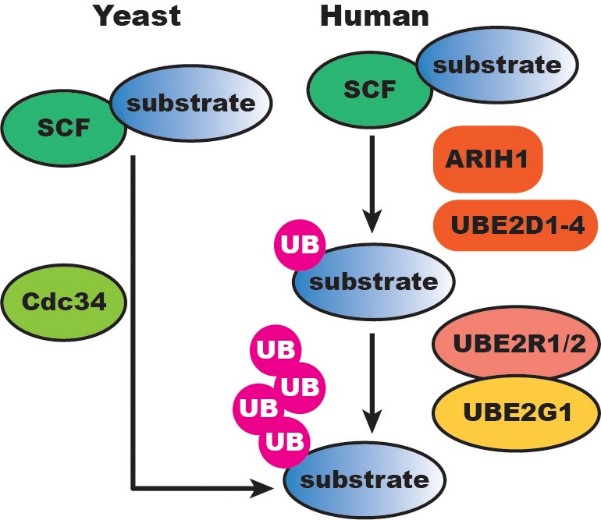
Fig1. SCF-catalyzed substrate ubiquitylation is extensively buffered at the initiation and elongation steps in human cells compared to the simper yeast SCF system. (Spencer Hill, 2019)
UBE2G1 Related Signaling Pathway
UBE2G1 protein is mainly involved in the signaling pathway of the ubiquitin-proteasome system. In the process of protein degradation, ubiquitination involves three types of enzymes: ubiquitin-activating enzyme (E1), ubiquitin-binding enzyme (E2), and ubiquitin-protein ligase (E3). UBE2G1, as a member of the E2 enzyme class, is responsible for accepting ubiquitin from the E1 complex and covalently attaching it to the target protein. This process may be especially important for marking the degradation of specific proteins in muscles. Through the degradation pathway of the ubiquitin-proteasome system, cells are able to regulate a variety of biological processes, including the cell cycle, regulation of gene transcription, and elimination of abnormal or short-lived proteins.
UBE2G1 Related Diseases
UBE2G1 protein is closely associated with a variety of diseases, including breast cancer, prostate cancer, colon cancer, lung cancer, hepatitis B, congenital heart disease and so on. In addition, UBE2G1 protein has been implicated in neurodegenerative diseases such as Alzheimer's and Parkinson's disease.
Bioapplications of UBE2G1
Since these biological processes are closely related to the development of a variety of diseases, such as cancer, neurodegenerative diseases, and certain genetic diseases, the application of UBE2G1 protein is mainly focused on disease mechanism research and potential drug development.
High Purity
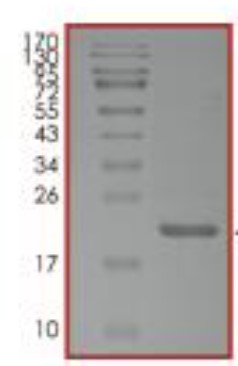
Fig1. SDS-PAGE (UBE2G1-648H) (PROTOCOL for western blot)
Case study 1: Gang Lu, 2018
The cereblon modulating agents (CMs) including lenalidomide, pomalidomide and CC-220 repurpose the Cul4-RBX1-DDB1-CRBN (CRL4CRBN) E3 ubiquitin ligase complex to induce the degradation of specific neomorphic substrates via polyubiquitination in conjunction with E2 ubiquitin-conjugating enzymes, which have until now remained elusive. Here the researchers show that the ubiquitin-conjugating enzymes UBE2G1 and UBE2D3 cooperatively promote the K48-linked polyubiquitination of CRL4CRBN neomorphic substrates via a sequential ubiquitination mechanism. Blockade of UBE2G1 diminishes the ubiquitination and degradation of neomorphic substrates, and consequent antitumor activities elicited by all tested CMs. For example, UBE2G1 inactivation significantly attenuated the degradation of myeloma survival factors IKZF1 and IKZF3 induced by lenalidomide and pomalidomide, hence conferring drug resistance. UBE2G1-deficient myeloma cells, however, remained sensitive to a more potent IKZF1/3 degrader CC-220.
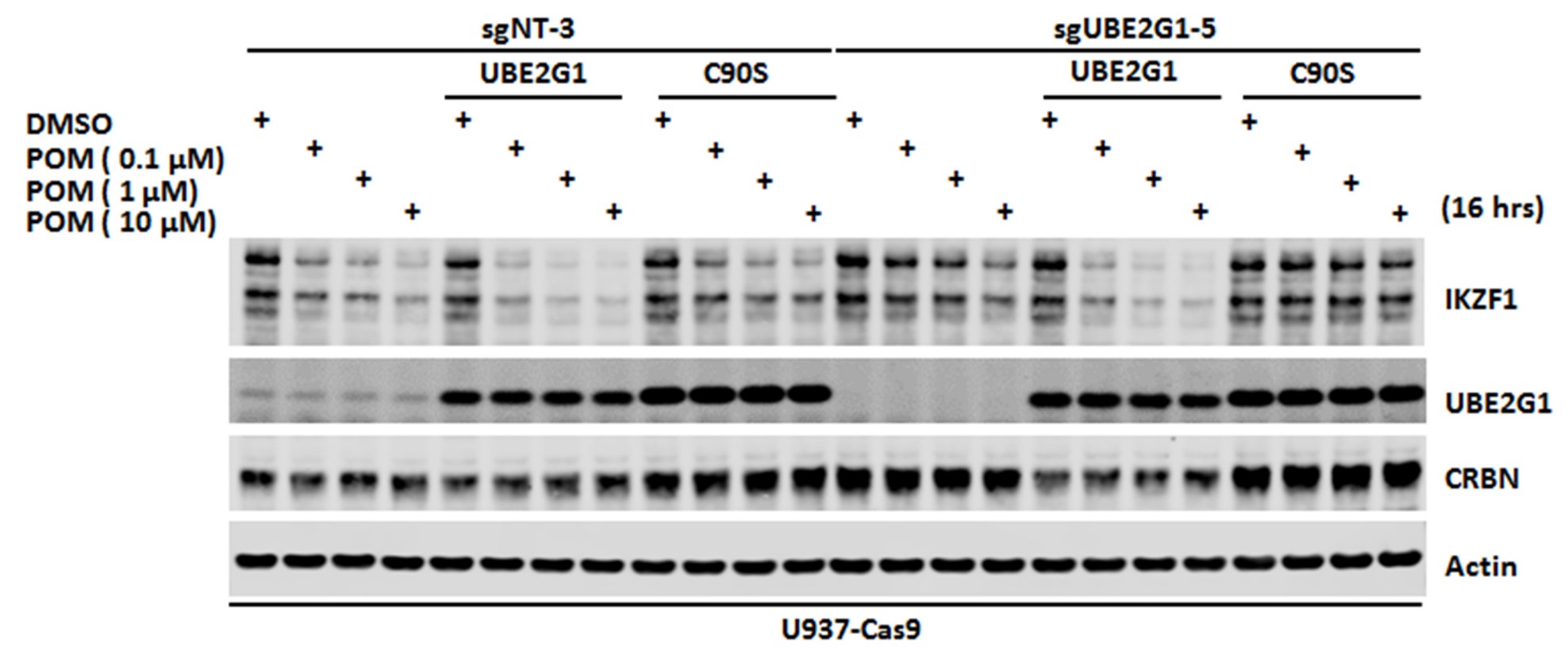
Fig1. Immunoblot analysis of U937_Cas9 parental or UBE2G1-/- cells with or without stable expression of UBE2G1 wild-type or C90S mutant.
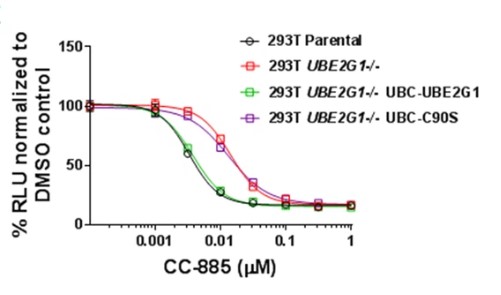
Case study 2: Jia Peng, 2022
The large yellow croaker (Larimichthys crocea) is one of the most economically valuable mariculture fish in China. Infection of Pseudomonas plecoglossicida can cause an outbreak of "internal organ white-spot disease", which seriously affects the aquaculture of the large yellow croaker. Ubiquitylation is closely related to the post-translation modification of proteins and plays a vital role in many hosts' immune defense pathways, while the E2-binding enzyme is a key factor in ubiquitination.
The previous genome-wide association study found that the ubiquitin-binding enzyme E2G1 (designed LcUbe2g1) was one of the candidate genes related to disease resistance in large yellow croaker. In this study, the researchers analyzed the molecular characteristics, function, and immune mechanism of the LcUbe2g1. The results of the RT-qPCR and immunohistochemistry analysis revealed that its transcription and translation were significantly activated by the infection of P. plecoglossicida in large yellow croaker. Immunocytochemistry experiments verified the co-localization of LcUBE2G1 and the ubiquitin proteins in the head kidney cells of large yellow croaker. Through GST pull-down, we found that LcUBE2G1 interacted with NEDD8 to co-regulate the ubiquitination process.
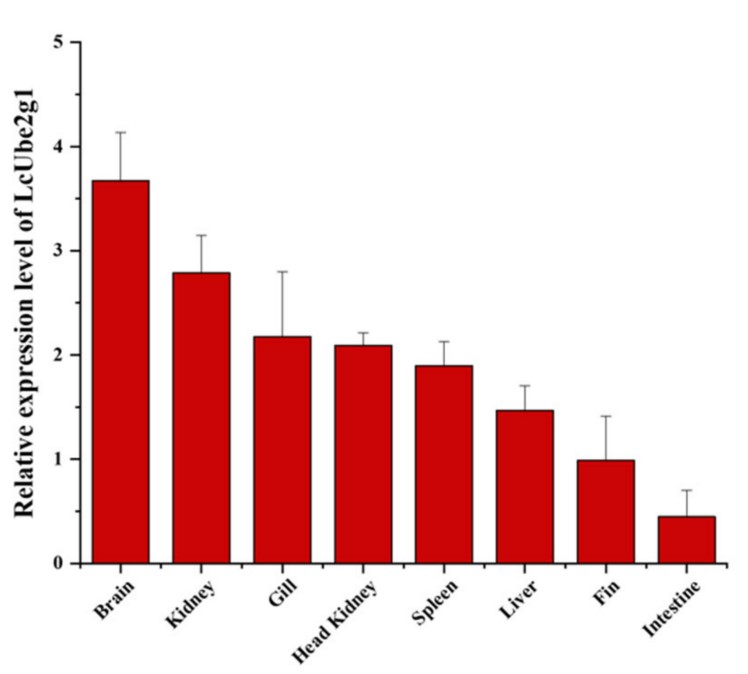
Fig3. Relative transcript levels of LcUbe2g1 in different tissues.
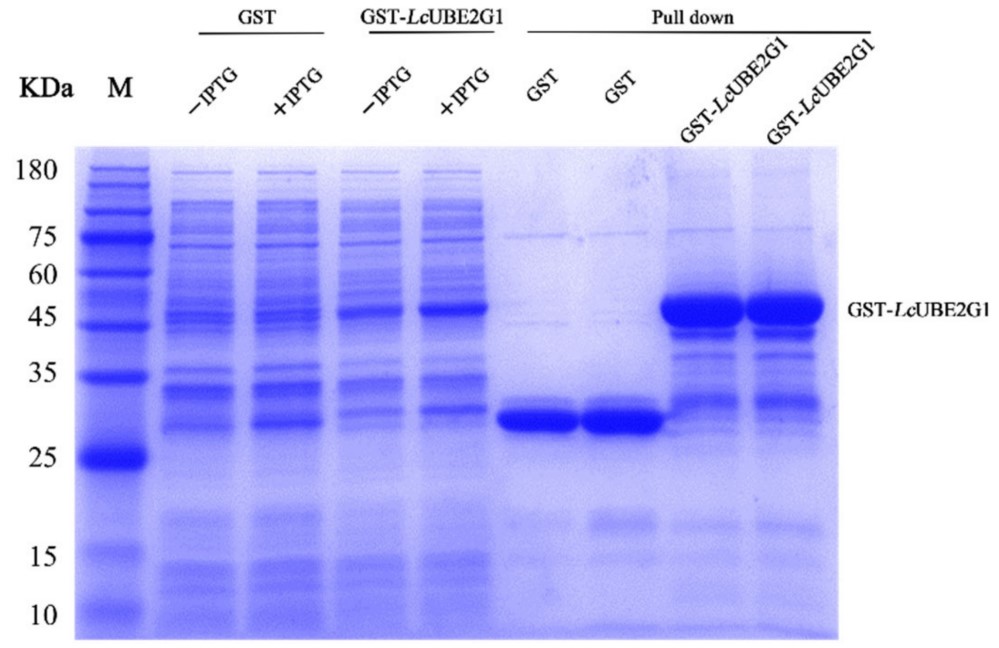
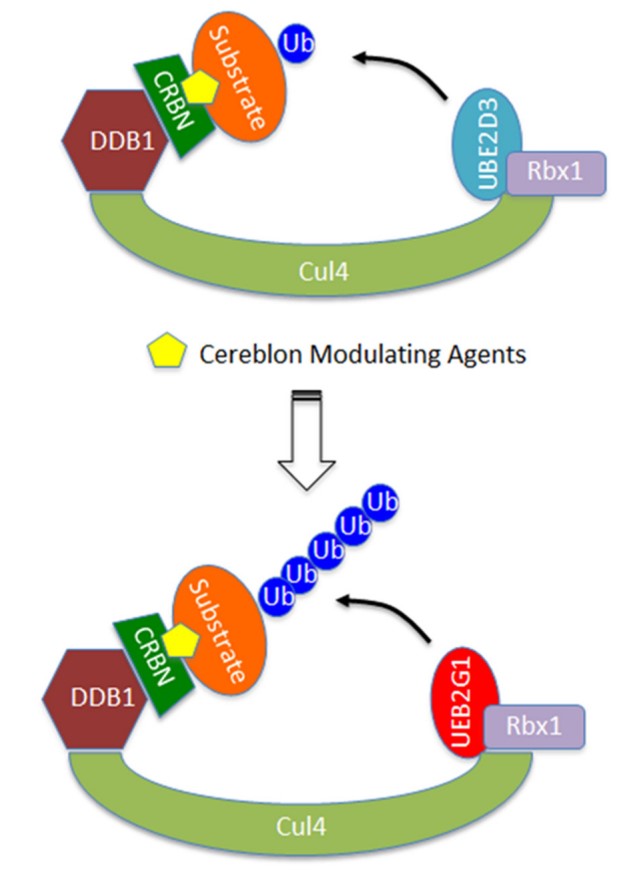
Fig1. Schematic showing the sequential ubiquitination of CRBN neomorphic substrates by UBE2D3 and UBE2G1. (Gang Lu, 2018)
UBE2G1 involved in several pathways and played different roles in them. We selected most pathways UBE2G1 participated on our site, such as Ubiquitin mediated proteolysis, Protein processing in endoplasmic reticulum, Parkinsons disease, which may be useful for your reference. Also, other proteins which involved in the same pathway with UBE2G1 were listed below. Creative BioMart supplied nearly all the proteins listed, you can search them on our site.
| Pathway Name | Pathway Related Protein |
|---|---|
| Ubiquitin mediated proteolysis | ANAPC13;FBXW11A;BTRC;UBE3C;HUWE1;SIAH1A;SAE1;FBXW11B;UBE2D1B |
| Protein processing in endoplasmic reticulum | SYVN1;PKZ;CALR3B;SEC13;RAD23B;EIF2S1B;DNAJB1A;UBE2E2;RPN1 |
| Parkinsons disease | SLC18A1;UBE2G1;UBE2J2;PARK2;NDUFB1;MT-ATP6;NDUFB2;NDUFA8;NDUFC1 |
UBE2G1 has several biochemical functions, for example, ATP binding, ubiquitin conjugating enzyme activity, ubiquitin protein ligase activity. Some of the functions are cooperated with other proteins, some of the functions could acted by UBE2G1 itself. We selected most functions UBE2G1 had, and list some proteins which have the same functions with UBE2G1. You can find most of the proteins on our site.
| Function | Related Protein |
|---|---|
| ATP binding | ABCB1A;CDK11B;PKDCC;CHUK;DDX58;KITB;PDGFRB;PEBP1;KIF26A |
| ubiquitin conjugating enzyme activity | UBE2C;UBE2E3;UBE2E2;CDC34;UBE2D4;UBE2N;UBE2S;UBE2J1;UBE2V1 |
| ubiquitin protein ligase activity | MGRN1;DZIP3;ARIH2;PJA2;UBE2KA;LRSAM1;SMURF1;HECTD2;HERC3 |
| ubiquitin protein ligase binding | UBE2W;CUL9;PARK2;TNFRSF1B;MAP1LC3C;NFKBIA;CALR;CHEK2;ATXN3 |
| ubiquitin-protein transferase activity | RNF146;RAG1;FBXL21;RNF152;ANKIB1;FBXO30A;HECW1B;BIRC5;RNF43 |
UBE2G1 has direct interactions with proteins and molecules. Those interactions were detected by several methods such as yeast two hybrid, co-IP, pull-down and so on. We selected proteins and molecules interacted with UBE2G1 here. Most of them are supplied by our site. Hope this information will be useful for your research of UBE2G1.
CUL1; RBCK1; Tmed10
- Q&As
- Reviews
Q&As (6)
Ask a questionStudies have shown that UBE2G1 may be associated with the onset of cardiovascular diseases such as atherosclerosis and myocardial infarction.
Drug development for UBE2G1 is currently in clinical trials, including small molecule inhibitors against UBE2G1 and inhibitors against the UBE2G1 signaling pathway.
There is no direct way to increase the expression level of UBE2G1, but it can be improved by regulating gene expression and providing nutritional support.
Studies have shown that UBE2G1 can be involved in the regulation of antiviral immune responses and affect the course of viral infection.
UBE2G1 plays an important role in the pathogenesis of certain autoimmune diseases.
In clinical practice, the expression level of UBE2G1 can be measured to predict disease progression and prognosis, and to guide the choice of treatment regimen. For example, in the diagnosis and treatment of cancer, measuring the expression level of UBE2G1 can help doctors determine the type, stage and prognosis of the disease, and guide the choice of treatment plan.
Customer Reviews (3)
Write a reviewThe experimental results using UBE2G1 are accurate and reliable, and the data are highly scientific.
UBE2G1 has high yield and good economic benefits.
The price is reasonable and the quality is very good. I'm very satisfied.
Ask a Question for All UBE2G1 Products
Required fields are marked with *
My Review for All UBE2G1 Products
Required fields are marked with *


